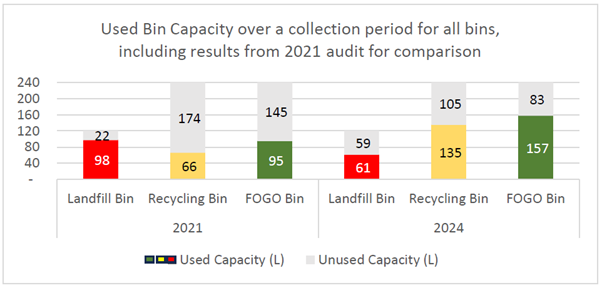Kerbside waste audits
Why do a waste audit?
Performing a waste audit allows Council to evaluate the composition, weights and volumes of various waste streams. It helps us get an understanding of contamination levels, compare to previous audits and enables us to use the data to identify opportunities for the future, such as education.
An overview of our 2024 kerbside waste audit
The audit 2024 showed that 61L (51%) of the landfill bin was utilised, or 7.1 kg, compared with 98L (82%) in 2021. For the recycling bin, the used bin capacity was 135L (56%) compared to 66L (27%) in 2021, or 3.6kg per household weekly. Finally, the organics bin had 157L used (66%), compared to 95L (40%) in 2021, equating to 9.6kg per household weekly.

Additionally, the overall weekly composition by weight and volume percentage in each bin is illustrated in the figure below.

LANDFILL
- Recyclables made up 23.6% of the total landfill bin content by volume, or 10.6% by weight. Redirecting these materials to recycling bins can promote a more circular economy within the community, reduce the need for landfill space, and lead to cost savings.
- Recyclable plastics and paper cardboard accounted for 82% of these recoverable materials by volume, occupying 7% and 12% of the total landfill content respectively.
- Approximately 8% by weight and 11% by the total landfill volume was made up of non-hazardous items that are accepted at the transfer station. The majority of this was textiles, with 7.8% of the total landfill volume.
- Finally, hazardous items such as batteries and e-waste accounted for 3.4% of the total weight, and 0.9% of the total volume.
RECYCLING
- A total of 17.7% by weight and 14.0% by volume of the total recycling bin content was categorised as landfill acceptable waste, however only 12.3% by weight and 7.5% by volume was residual waste.
- 16.7% of the total content of the recycling bin by weight, or 2% by volume, accounted for non-CDS glass.
- CDS glass accounted for 7.4% by the total weight and 1.7% of the total volume. This equates to 2.5 litres of glass per week per household on average in total, or 10 litres per month. Removing this glass from the recycling bin will not only reduce the used bin capacity, but also ensure that the remaining streams are less contaminated and more of it can be recycled.
ORGANICS
- The organics bin contained 99.46% acceptable organic material by weight, demonstrating successful organic waste diversion compared to a contamination rate of 1.7% in 2021. The significant increase in organic content compared to 2021 reflects the community's growing adoption of organic waste separation, likely driven by targeted educational campaigns and improved service provision.
- In a sample of 66kg of bagged food organics, around 1.4% of contamination was identified. Larger branches not acceptable in the kerbside bin, but acceptable at the resource recovery centre, accounted for 0.38% by the total weight and 0.33% of the total volume.
- Based on the assumption that 2-4L of an 8L bag was used for food organics, an average of 51-103 bags for 160 households, or 0.3-0.6 bags per household, per fortnight is generated.
CONTAINER DEPOSIT SCHEME
In total, including eligible CDS glass, approximately 866 eligible CDS containers are found in the recycling bin each week, and 144 in the landfill bin for 160 households.
SOFT PLASTICS
Soft plastics accounted for 16.7% by volume and 4.07% by weight in the landfill bin.
How do we, as residents, improve?
- We can ensure all food and garden waste goes into your organic green lid bin. Why? We need to divert as much waste as possible from landfill. Moira Shires only landfill has a limited capacity. Organic waste makes up a large proportion of our household waste and when added to landfill is broken down in an anaerobic environment (that's an environment without oxygen) and creates methane, one of our worst greenhouse gases! These gases contribute to global warming therefore the need to reduce these gases is essential. And what better way to divert it from landfill and recycle it into a valuable product.
- Use Moira's Waste Info App or A-Z guide for assistance when unsure of what items go in which bin.
- Check your packaging for recycling information. More and more packaging has the Australasian Recycling Label to help us better understand what goes where.
- Reduce packaging where possible. Say no to that plastic bag, get your cucumber with no plastic wrap.
- Recycle as much as you can. Use other recycling options such as take your soft plastics to your local Resource Recovery Centre, use Moira's recycling stations for those hard to recycle items like batteries.